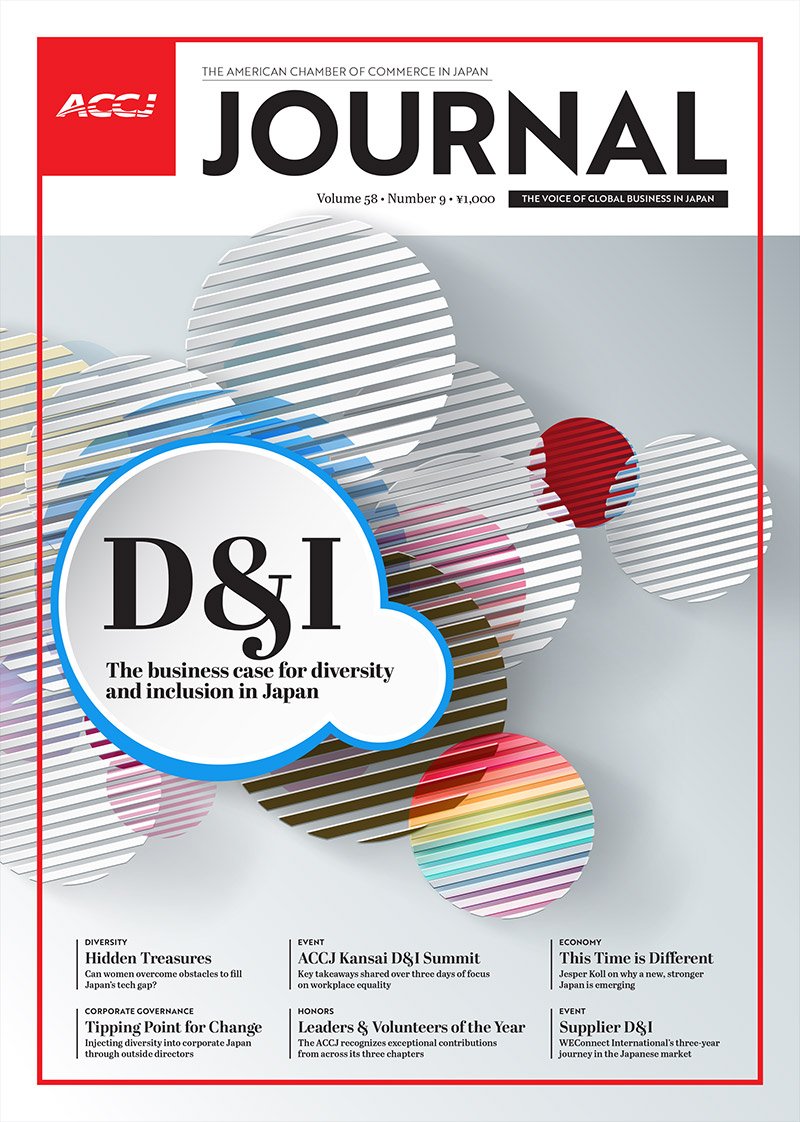This Time Is Different
A new and stronger Japan emerges
By Jesper Koll
“This time is different.” These are four very dangerous words. When you hear them, it always pays to be extra skeptical—especially in the context of someone giving you financial advice or presenting an economic forecast. Personally, I always hold on to my wallet extra tight when the “trust me, this time is different” clause is invoked. We’ve all been there in our respective professions and passions; it takes a thief to know a thief.
As an economic strategist and professional Japan optimist, I certainly do have an extra hard time trying to make my case. The legacy of Japan’s lost decades (1991–2009) is incredibly strong. I often get a similar reaction to the one that hard-core Elvis fans must get when they insist that the King lives on. However, unlike the King of Rock ’n’ Roll, the Japanese economy is very much alive. In fact, there is plenty of hard empirical evidence that Japan not only has changed, but also that it has what it takes to be an economic powerhouse—and the envy of the world in terms of economic sustainability.
So, what’s different this time? Why won’t Japan slide back into another lost decade? That won’t happen because three fundamental forces have changed from negative to positive:
Corporate ownership
Public policy
Focus among the elite
Competition Welcome
The ownership structure of corporate Japan has changed from a closed, insider-based system to an open, competitive one.
In economics, nothing matters more than ownership. Equity ownership dictates the allocation of resources. It is the very basis of power for all the essential corporate decisions: financial, strategic, human capital. Ownership defines the true corporate culture. Twenty years ago, more than half the equity ownership of Japan Inc. was tied up in mochiai (cross-shareholding). Today, it is less than five percent.
This breakdown of Japan’s keiretsu (company network) ownership structure is the key reason to be bullish on Japan. The old Japan Inc. was a system of insider capitalism that incentivized bad economic decision-making. Group banks kept lending to group companies, not on the basis of economic merit but for the sake of maintaining relationships. Supply-chain group companies were forced into utter dependence on the conglomerates and the banks that owned them. This allowed de facto zero price power and no room for competitive diversification or independence.
Imagine if your company had been built using your brother-in-law as a supplier. Cutting him off when a more efficient and better supplier emerged basically would be impossible, while incentivizing him to change his ways would take time.
In finance, the mochiai fueled a debt bubble and then kept zombie companies alive for much longer than their economic worth warranted. In management, this enforced a “closed fortress” corporate culture of rule followers and yes-man workers who, in the case of failure, had nowhere to go, because the other fortresses were not open to them.
In contrast, today’s corporate Japan has liberated itself from the group-ownership straitjacket and has turned from a membership-only club to an open-for-business structure.
The recent case involving attempted shareholder vote suppression at Toshiba Corporation proves the point. The old Japan Inc. would have gone out of its way to keep Toshiba in the group, thus holding the company’s assets hostage to continued in-group control. Instead, Toshiba’s ownership has fundamentally changed.
Outside capital has come in and the assets are being strategically refocused on core competence. This includes previously unthinkable actions. Shareholders ousted the chief executive officer and chairman, while the board has become dominated by outside directors’ opinions—even going so far as to propose a breakup of the company as the best forward strategy for all stakeholders.
Just a couple of years ago, such moves were unimaginable; but now they are happening. While Toshiba is a dramatic case, we are seeing many examples of economically rational changes in corporate strategies across all industries.
Make no mistake—this new openness has been made possible by the removal of the cross-shareholding structure. Japan Inc. has turned from being closed and insider-focused to being open; not just for business, but to new strategic partnerships, open innovation, and letting core-competence assets sweat like never before. Yes, it is different this time.
Pro-growth Policy
Public policy has changed from political instability and ad hocism to stability and pro-growth consistency.
From 1990 to 2012, Japan had one of the most unstable political leadership regimes in modern history. In contrast, today’s Japan has become a bastion of political stability. Yes, we’ve just had an election, and a new prime minister, Fumio Kishida, has taken office, but the policy team is full-on Liberal Democratic Party (LDP). In sharp contrast to the aforementioned period of regime uncertainty, today the LDP controls just about two-thirds of the Diet.
Make no mistake: Japan’s LDP is the envy of the democratic world. Unlike the situation for leaders in the United States and most European countries, where ruling parties are struggling to secure a majority, Kishida’s political and parliamentary control is rock solid. He can actually get things done. This is good news for the private sector—whether we identify as entrepreneurs, business leaders, investors, consumers, pensioners, or a combination thereof.
Of course, you may agree or disagree with some of Kishida’s policies but, most importantly, he is turning out to be completely predictable and his actions are consistent with those of his predecessors. Just like former Prime Minister Shinzo Abe, he immediately got to work and ordered a record boost in fiscal spending. Also like Abe, he instructed the central bank to reaffirm the two-percent inflation target.
Again, Japan stands out compared with the United States and European nations, which all are beginning to cut back on policy stimulus. Clearspeak: Kishida may have campaigned on promises to create a new form of capitalism; but the moment he took office, he turbocharged exactly the same old engines of growth used by his predecessors.
For the private sector, the predictability and consistency of policy is often more important than the content. The worst thing the government can do is to flip-flop. The less trust entrepreneurs and business leaders can place in stable policy—whether tax and labor laws, investment rules, energy policy, or healthcare costs—the more cautious they become. Just as Japan’s political stability during the 1960s, ’70s, and ’80s was important to her economic success, the trap of political instability and regime uncertainty was a huge negative factor cutting down corporate animal spirits and the private sector’s willingness to take risks and invest for the future.
Whether or not you like Team Kishida, the major players do have a solid track record of being pro-business and pro-growth. There’s no question that more could be done to promote entrepreneurship and growth, but the basic direction is constructive. Most importantly, a premature tightening of policy is now unlikely. Where the 1990–2012 period was marked by repetitive stop-go-stop monetary and fiscal boom–bust cycles, Team Kishida is keeping a steady course of modest fiscal and monetary support.
In turn, this creates ideal conditions for the private sector to develop not just stable growth, but to reach escape velocity. Yes, this time is different—but not because Kishida is creating a new kind of capitalism, but because he’s Machiavellian enough to begin by sticking with old and trusted methods.
Ominously, in Kishida’s inaugural policy speech to the Diet, he chose not to mention the word reform even once. He is basically the first prime minister in more than two decades to omit it. I am told this is because he sees himself as a builder, not a reformer. If so, that could be great news. Japan thrives on the concept of kaizen, (step-by-step, incremental improvements). A builder and master-craftsman is much more revered than an ambitious reformer.
A Transformed Elite
Corporate ownership and political stability are the deep structural changes that have taken place but, perhaps most importantly, the motivation and ambition of Japan’s ruling elite has found a new focus. Simply put, the rise of China from developing economy to global competitor has focused their minds as nothing else has in decades. No, Japan does not want to become an economic colony of China.
While the past decades were marked by defeatism and fatalism, today’s Japan is marked by ambition, confidence, and a newfound idealism. Whether they are new entrepreneurs, the next generation of big-business CEOs, or the new leaders of the LDP, Japan’s elite are now united in their ambition to reassert Japan’s rightful place as a globally relevant, top-tier nation and global rule maker.
Japan wants to be Japan, not the United States and not China. Nobody yet knows what the new Japan will look like, but make no mistake: a new Japan is being created.
Yes, this time is different.
Jesper Koll
Global ambassador
Monex Group Inc.
THE ACCJ JOURNAL
Vol. 58 Issue 9
A flagship publication of The American Chamber of Commerce in Japan (ACCJ), The ACCJ Journal is a business magazine with a 58-year history.
Christopher Bryan Jones,
Publisher and editor-in-chief
Advertising & Content Partnerships



